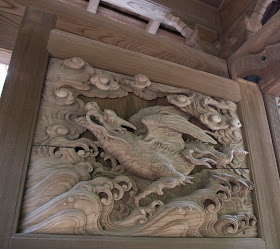Previous posts in this series:
- Heijūmon
- Kabukimon
- Kōraimon
- Yakuimon
- Yotsu-ashimon
- Munamon
- Commentary
- Uzumimon
- Yaguramon
- Rōmon
- Shōrōmon
- Taikomon
- Nijūmon
- Sanmon
- Niōmon
- Nitenmon
- Sōmon
- Wakimon
- Chokushimon
- Onarimon
- Tansōmon
- Zuijinmon
- Miyukimon
- Agetsuchimon
Mukai-karamon (向唐門)
We've seen a few of these already in this series, going by other names. Mukai (向) means 'facing', and karamon (唐門) means 'Chinese' gate. It does not derive from any actual Chinese gate form that I'm aware of - it is called 'Chinese' in the same way that an American at some point in the past might call something fancy and exotic, 'European'. This type of gate has an undulating, or 'cusped' gable roof, and is by far my favorite form of roof on a smaller gate. Structurally, the underpinnings are as for the yotsuashimon type, two main posts with four auxiliary support posts. Six legs on the ground but it is nonetheless a 'four-legged' gate. These gates associate more to temples than shrines, and are considered a 'high class' gate form by the Japanese. Feudal-era nobleman's houses might feature this form of gate, and only members of the very upper crust were permitted by sumptuary law to have this gate form.
In the 'mukai' form of karamon, the cusped gable end faces you when you approach the gate front-on. Let's look at an example, from the very large and elaborate Zen temple compound of Sōji-ji (總持寺) in Yokohama Prefecture:
A massive gate, I think the largest of this kind in Japan.
Open sesame:
From the inner courtyard looking out:
The imperial Chrysanthemum marks each of the doors:
Next, a grand gate at Nigitsu Jinja (饒津神社) in Hiroshima:
This one has the more 'pure' form of karamon roof, without any crosswise gables.
Front view:
You'll notice that the barge boards have a small point on their lower surfaces in the middle of their climb:
Picture courtesy of JAANUS. Those small points, or cusps, are called ibara (茨) in Japanese, which means 'thorn'.
Next one is also at a shrine, Tsutsujigaoka Tenmangu (榴岡天満宮) in Miyagi Prefecture:
The decorative rafters, shaped similarly to the barge boards, are termed ibara-daruki.
We're just getting warmed up with these! Consider this example, located at Engaku-ji (円覚寺) in Kamakura, founded in 1282:
Some stunning carving on this gate:
A door:
How about a closer look at that panel?:
The other door is no slouch either in the carving department:
Maybe a bit more of this carving is worth a look at?:
What's a gate without a dragon?:
So, if that hasn't overloaded you while touring Kamakura, just down the street, more or less is the temple compound of Kenchōji (建長寺) which has a magnificent mukai-karamon of its own:
A gilt and black-lacquered masterpiece, with a shingled copper roof. Doesn't get much better than that! Kenchōji, founded by the same patron as Engaku-ji, is the oldest Zen training monastery in Japan. Funny how most westerners associate Zen with austere minimalism when the architecture of Zen temples is anything but that.
Inside the courtyard the gate continues to shimmer:
Full frontal:
A near-side view, showing the sublime proportions, sinuous roofline, and, hey, this one actually IS a four-legged gate!:
Okay, let's switch gears and look at a much more humble and subdued example of the front-facing karamon. Here's the gate fronting the park at Ichijōdani Asakurashi Iseki (一乗谷朝倉氏遺跡) in Fukui Prefecture:
This 'park' is actually the ruins of the Asakura clan castle town, razed to the ground in 1573 after coming out on the losing side in a war with Oda Nobunaga.
That is a cherry tree in the background of the gate in the first picture - in spring it bursts into flower:
A closer look at the gate:
A view from the castle ruin grounds side:
One more for good luck - a side view:
More gates to come in this series! Thanks for your visit. On to post 26

























A most enjoyable installment. The door panel carving is incredible. The relief technique combines with the underlying wood grain to create a real satisfying visual depth. Conversely I find it a little disappointing when intricate carvings are covered by paint.
ReplyDelete-Mike
Mike,
Deletegood to hear that you are enjoying this series. I'm enjoying the topic myself!
~C
I remember thinking, when I first saw the renovated Kenshunmon at the old imperial Palace in Kyōto, that there is nothing more beautiful than a hiwadabuki roof with a karahafu gable. Thank you very much for this series on Japanese gates. I enjoyed it very much and considering that I only knew eight types of gates before, I learned a lot. May I ask if you use a special kind of reference work or dictionary for terms on Japanese architecture?
ReplyDeleteBest Regards, Eva
Eva,
Deletea pleasure to hear from you and I'm glad you enjoyed the series. I don't use any special reference work or dictionary. I do read Japanese reasonably well, and do my research primarily on the web. It's a matter of finding various leads and searching them our, following them to where they may lead. I do have a Japanese pattern book on gates as well, which is more technical yet, however I've generally been trying to spare readers an overload on Japanese terminology in this series.
I agree that hiwadabuki roofs are the most beautiful, however they are not especially durable (about 25~30 years only) and are very expensive. I've come to prefer copper shingled roofs, as they are light and durable, and look great.
~Chris